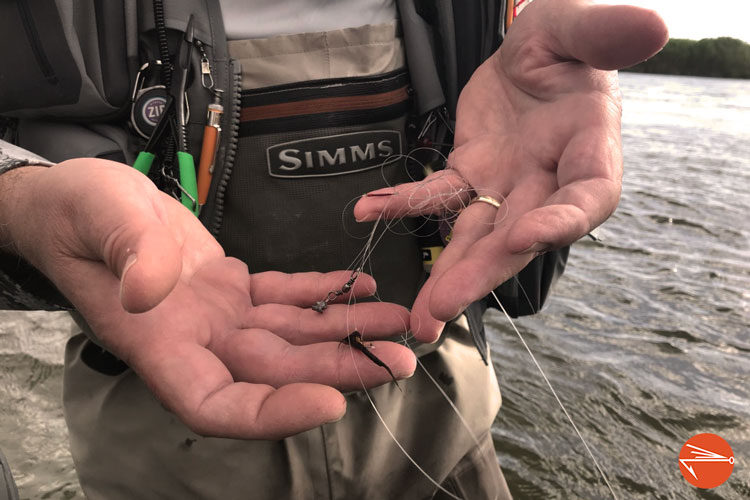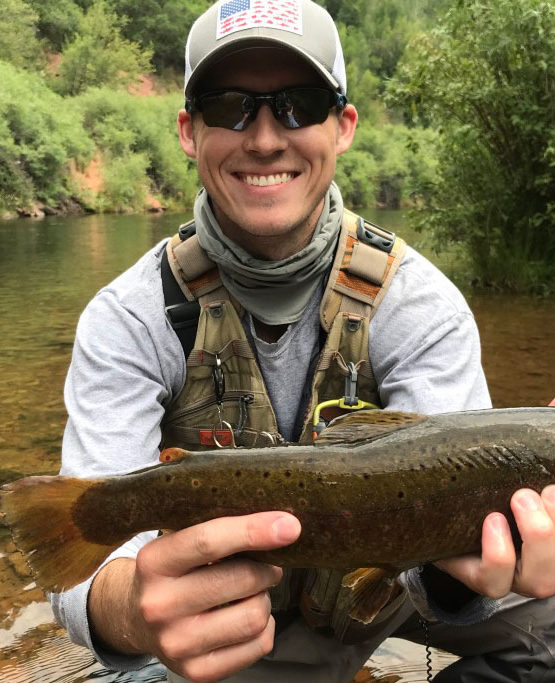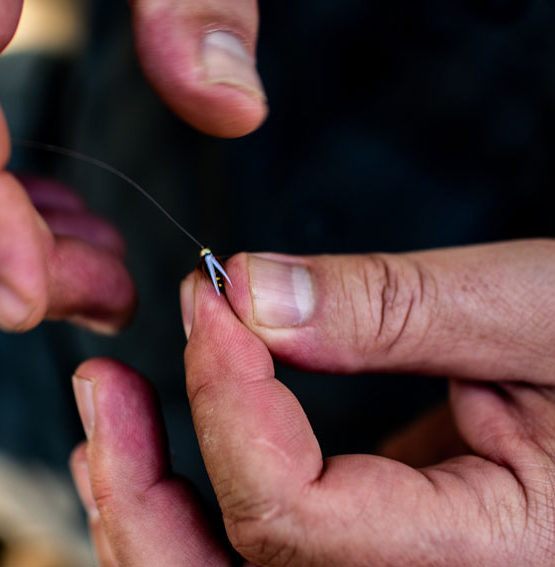Looking for some tips on how to avoid fly fishing tangles? You aren’t the only one.
One of the most frequently-occurring challenges all fly fishers encounter is a tangled line. So, if you happen to be searching for ways to reduce how often you find yourself detangling your rig, (when you’d really rather be catching more fish), you’ve come to the right place.
In this post, I’m going to lay out nine of the top strategies you can immediately employ to avoid fly fishing tangles. I’ll even throw out a few tips to get you out of that gnarly rat’s nest and back in action as quickly as possible. Alrighty then? Let’s dive in!
Disclaimer: This post may contain affiliate links, meaning we will receive a small commission (at no cost to you) if you click through and make a purchase.Fly Fishing Tangles: Two Schools Of Thought
Lucky for you, your two intrepid Fly Fishing Fix purveyors represent the two primary schools of thought on fly fishing rig tangles. Zach, the young buck, the millennial, the pragmatist, well, he’s the Mayor of Accept-Your-Medicine-and-Move-on-Ville. When faced with a nasty tangle, he will almost always cut the whole thing loose and start over. While I, on the other hand, might best be described as the old soul, the saver, the problem-solver, the Mayor of Jeff Spicoli’s My-Dad’s-Got-a-Great-Set-of-Tools-He-Can-Fix-It-Ville. I’m more inclined to spend the time to untangle my line rather than going with a full re-rig.
Maybe he’s Luke and I’m Yoda.
I don’t know.
What I do know is that I’ve endured more than my fair share of wicked fly fishing tangles and, yet, am NOT uniquely qualified to opine on the topic. In other words, every angler encounters ugly line messes from time to time. It’s inevitable. So, it’s best to just accept it as part of the fly fishing experience.
The good news is that, with careful adherence to a few easily-followed tips, rig snarl frequency can be minimized and their severity reduced. With that in mind, here are a few of my favorite strategies to avoid, or at least reduce fly fishing tangles.
Avoiding Fly Fishing Tangles
As we’ve quoted before, Ben Franklin said, “An ounce of prevention is worth a pound of cure.” I couldn’t agree more. In fact, in a very father-wise manner, I used to preach to my kids that it’s… “Easier to keep your room clean than it is to make it clean.” Or, as I’ve tried, somewhat unsuccessfully to apply to my own life: “It’s easier to stay fit than to become fit.”
In the same vein, the best way to reduce fly fishing tangles is to learn how to avoid them in the first place… and here’s how.
1. Uncomplicate Your Rig
A well-known fly fishing theorem that I just made up goes like this: “the probability of a rig tangle is directly proportional to the rig’s complexity.”
Every fly fisher knows this, but since I am the first to put words to it, it will heretofore be known as the “Buchenau Rig Snarl Theorem.” (I know. I’m a legend in my own mind.) But I digress.
Another truth about us anglers holds that the better we become at the sport, the more we think we can accomplish near-impossible feats.
We can make that long, upwind cast to that distant swirl right below that snaggy log.
We can cross that raging current to get to that sweet cut-bank on the other side.
We can throw that double-dry, double-dropper rig into that tight run under the willows.
And then, just as fast as we determined that we could, we discover that we can’t. Worse yet, we’re humbled by the resulting rig-wrecking snag or, just as often, the hopeless tangle in our line.
Since it isn’t likely that we’ll stop doing stupid things anytime soon, it will help if you uncomplicate your rig beforehand. Take that triple rig down to a double. Cast one dry to that distant swirl. Leave the dropper in your fly box for now. In other words, if you’re going to try something stupid, be smart about it.
Related Posts:
- How To Tie A Dry Dropper Rig (5 Simple Steps)
- How To Tie A Double Nymph Rig? A Step-By-Step Guide
- 25 Proven Tips To Catch More Trout
- 9 Killer Nymphing Tips For Beginners
- Fly Fishing With Small Flies (The Complete Guide)
2. Fish Within Your Capabilities
A close cousin of the uncomplicate your rig tip is the fish within your capabilities tip.
Although I do try the impossible from time to time, my inner Yoda has matured me over the years. I know what I can do, and I know what I can’t (or ought not try). Learning to live within your capabilities — to listen to that subconscious voice of reason — will dramatically reduce the frequency of rig tangles.
Clint Eastwood’s Dirty Harry character definitely had it right when he said, “A man’s got to know his limitations.”
3. Position To Reduce Snags
Every fly fishing aficionado will relate to this.
In your haste to get a fly to that rainbow you’ve spotted feeding in that inviting run below the toppled stump, alongside that section of overhanging pine branches, you compromised your approach and position. Instead of taking a little more time to get to the optimal spot, you decided to just cast away from ‘Position B’, knowing full-well that your hastily-chosen angle of attack would increase the likelihood of a snag. And then, when your rig drifts a little too close to said snag, you suddenly jerk it out on a bad angle. This necessitates a quick in-cast correction that almost always ends badly. Hello tangle!
Makes me shiver just thinking about it.
Avoid this regrettable scenario by taking the extra time to make it to ‘Position A’ before casting.
When you make that confident cast and, rather than screw up the run and spend the next twenty minutes detangling, hook up on that sweet rainbow, feel free to thank me with large sums of money.
4. Minimize Casting
When my son was a little guy just learning to fly fish, he would make lots of bad casts. Just as most beginning fly fishers are inclined to do, his first reaction was to try to correct it with an immediate recast. As his instructor, and only because of what my father taught me when I was the one making bad casts, I would usually tell him to, “Leave it.”
Aside from the fact that bad casts often result in good strikes, an immediate recast increases the probability of a tangled rig.
Unless it’s a total disaster, my advice is to leave more bad casts in the water to drift out before re-casting.
You’ll be surprised how often what you thought was a bad cast results in a take. And even if it doesn’t, letting your rig drift out before recasting will straighten out your line for a clean next cast. It will also reduce the possibility of spooking the hole.
As an addition to this tip, too much false casting increases the chances of rat’s nests as well. If you’re drying your fly between casts, try to keep your false casting down to two or, at most, three ‘falsies’ before getting your fly back in the water.
5. Listen To And Obey Your Fly Rod
One sure sign of a line tangle is when your line hits your rod during a cast. This tends to happen more often and more severely when casting a weighted rig, but when you hear (or feel) your line hit your rod, immediately stop your casting motion and carefully, while making sure your rod stays as still as possible while doing so, assess your rig. More often than not, it will have tangled. If you had the discipline to instantly cease all casting action when your line hit your rod, it will probably be easier to untangle. On the other hand, if you kept on a-castin’, the line mess you wind up with is on you.
Here’s an immutable rule of fly fishing you must commit to memory: Tangled fly fishing rigs only get worse with continued motion. They do not, ever, ever, ever, ever, untangle themselves as you whip them about in frustration.
And here’s the one distant exception to this rule: On occasion, when the planets are aligned and when the lion speaks, a small tangle will fall straight with a light jiggle. (But don’t bet the house on it.)
Related Posts:
- What Is The Best All-Around Fly Rod Weight?
- How To Set The Hook When Fly Fishing
- Is Fly Fishing Hard To Learn? (The Truth)
- 25 Tips For Fly Fishing Small Streams And Creeks
- 21 Common Fly Fishing Mistakes To Avoid
6. Watch And Feel Your Rig
When fishing with a single dry fly, it’s fairly easy to see when your rig has developed a tangle. This gets a bit more difficult when casting a weighted, multi-fly rig.
Nevertheless, as your fly fishing experience grows, you’ll quickly learn to watch and eventually feel your rig for anything that just isn’t right. Sometimes the fish you’re casting to will be the first to let you know. Watch for a hot streak that suddenly and inexplicably ends. While such an occurrence may suggest that something else has changed — the weather, the hatch, the water temperature — it’s often an indicator that your rig has become jacked-up.
At other times, when something doesn’t look or feel right with your rig, it undoubtedly isn’t.
As soon as this occurs to you, stop casting, stop mending… heck, stop breathing!
Then, as suggested previously, carefully inspect your rig. The sooner you recognize that you have a rig problem and initiate tangle-mitigation efforts, the less time you’ll have to spend correcting it.
Okay, you can start breathing again.
7. When In A Hole, Stop Digging
Perhaps you’ve detected a theme in this post. It’s as important in fly fishing as it is in life. When you find yourself in a hole, stop digging! This tangle-reducing tip may just be the most important one. If you become aware that your line is messed up, assess the damage, accept the situation, embrace the horror, and either go get yourself an attitude-adjusting brewski or take a deep breath and go about the work of fixing it. (Or, combine those activities if you must.)
And by the way, if you decide to re-rig, please don’t cut away your line and leave the mess laying on the ground somewhere. Tuck it away in a free pocket and throw it away properly later. Or, better yet, snap a photo of it and send the image of your epic tangle to us at Fly Fishing Fix. It may just find its way into our forthcoming Rat’s Nest Hall of Fame.
8. Practice Patience
Fly fishing can certainly produce feelings of frustration, especially if you find yourself in the throes of a sequence of what we refer to as a “full-on flail.”
Since it makes me shiver to think about, let alone describe, let me just say that you’ll know it when you’re in one. When (not if) you find yourself in that nasty zone, count to ten, resist the urge to snap your rod, and don’t make a bad situation worse with a spastic outburst. Fly fishing rigs seem to know when their masters are losing it. And because they also seem to possess a sick sense of humor, will allow themselves to get into worse shape right when it’s least welcome.
When the frustration builds, I find it advantageous to stop, breathe, consider my beautiful surroundings, that I’m fly fishing, that I’m not in the office, that I’m with good friends and treasured family, and that I have a good sandwich and a cold one waiting for me in the boat. Life is good. At that moment, the act of trying to catch a fish on a fly becomes less important, my previously elevated blood pressure comes down, and I find myself in a much better frame of mind to fix my rig than I was just a few minutes earlier.
9. Respect The Wind
This tip may be out of place in this post’s sequence, but I couldn’t leave wind out of the discussion. As any fly fisher knows, wind will do everything it can to try to tangle your line. Therefore, the best thing you can do on a windy day fly fishing is to respect the wind, try to position yourself on the water to make it work for you, and practice the tips in this post even more carefully than you would on a calm day.
In the words of Forrest Gump, “That’s all I have to say about that.”
Bonus: A Few Detangling Tips
I promised to offer some tips to make the detangling process go faster. No matter how carefully you adhere to the tangle-reduction strategies in this post, tangles will happen. When they do, consider a few of my go-to strategies.
Assess Whether To Detangle Or Re-rig
What makes the decision to detangle or re-rig difficult is that some apparently simple tangles wind up being difficult to untangle, and that some apparently difficult line messes come apart quickly.
Experience comes into play here, as does your level of patience, dexterity, expertise and, of course, weather conditions. Taking all of that and more into account, make your decision and be at peace with it. As I noted early on, I lean toward detangling. That said, I can’t tell you how many times I’ve headed down that road only to give up, sit down and re-rig.
Get Out Of The Wind
Whether you’ve decided to detangle or re-rig, wind is not your friend. It will gust and swirl your leader, tippet and flies in all sorts of irksome ways. So, if you can, get the heck out of the wind!
If that’s not possible, at least turn your back to it and work as close to your chest as you can.
Dry And De-Goop Tangles First
Wet, goopy line snarls are much more difficult to untangle than dry, clean ones. Simply put, before attempting to right the rig wrong, carefully remove goop, reeds, burrs and other whatnot. Then, let the whole tangle dry out for a minute or two before diving into the detangling puzzle. Incidentally, this is a good time to remember that you’re in your happy place, and that there’s a Yeti full of ice-cold brews waiting for you back at the truck.
Work Outside In
If you’ve decided to try to untangle your jacked-up rig, I suggest working from the last bug (or end) backward. This method has always served me well. Unlike undoing a tight knot in a shoestring, rig tangles, though often complicated, are usually not composed of tight knots. Rather, they tend to be an amalgam of loose loops and twists that can be deconstructed in the reverse of how they came to be. Try this technique. See if it doesn’t help you get out of jams quicker while also saving more rigs.
By the way, tangles tend to leave kinks and bends in your leader and tippet. Once you’ve accomplished the detangle, it’s a good idea to give the whole rig a gentle stretch or, if you have one handy, use a line straightener (like this one by Dr. Slick) before casting again.
Cutting Away
A guide I once worked with made a simple yet profound (in the fly fishing sense) statement that I’ve never forgotten. He said, “When your flies aren’t in the water, you’re not catching fish.”
Duh! I thought, but it stuck with me anyway.
In the same elementary vein, tangles equal flies out of the water. At Fly Fishing Fix, we want to help you keep your flies in the water and keep you catching fish as often as possible. Follow the tips above and you’ll increase your fish-catching time at least tenfold. Though it may sound overly confident on our part, if you subscribe to Fly Fishing Fix–and visit often–it’s possible you’ll increase it a hundredfold.
I’m betting your inner Yoda would love that!
Tight Lines!










